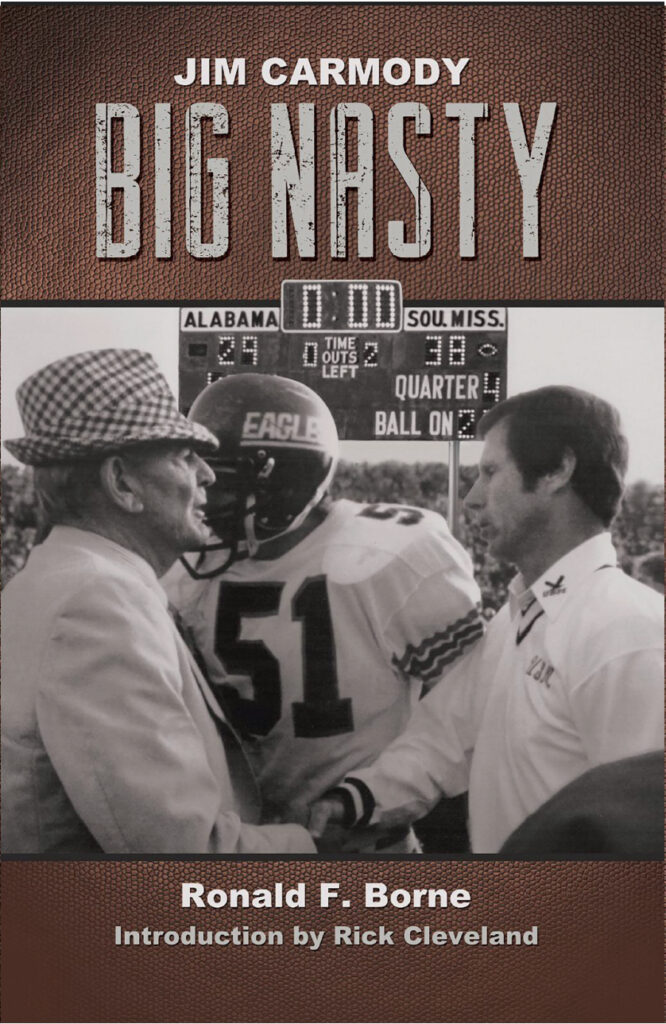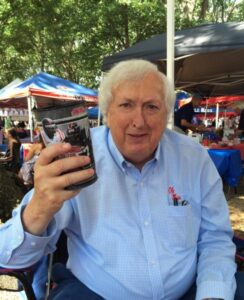
Editor’s note: Jim Carmody, the subject of Ron Borne’s biography, “Jim Carmody, Big Nasty—Mississippi’s Coach,” and veteran sports columnist Rick Cleveland will be at Off-Square Books in Oxford at 5 p.m., Monday, October 30, for an event featuring this book.
Jim Carmody, Big Nasty – Mississippi’s Coach. By Ronald F. Borne. Nautilus Publishing, 344 pages, $24.95.
He could take his’n and beat your’n and take your’n and beat his’n. That football compliment sums peculiarly well the career of Jim Carmody, one of the most formidable figures in the bruising three-cornered welter that is Mississippi football.
Across 30 seasons, from 1964 through 1994, Carmody coached football at Ole Miss, at Mississippi State, and at Southern Mississippi, and for each school won victories against the other two. Author Ron Borne writes:
“If [Carmody] was coaching at Ole Miss, he pointed to games against State and USM. If he was coaching at State, then Ole Miss and Southern were his two biggest rivals, and when he coached at Southern, then State and Ole Miss were his biggest rivals. Carmody posted a 22-14 record in these rivalry games.”
Carmody had to be competitive and deadly serious. Amid reversals, upsets and ironies, he was virtually playing against himself.

Borne sets Carmody’s career in the context of two legendary triumphs. In 1982, the first year that Carmody was head coach at Southern Mississippi, his team beat Alabama in Tuscaloosa. In the Bear Bryant era, any team that beat Alabama had beaten the odds—but Carmody’s victory was more. It was the first home game that Alabama had lost in 19 seasons, and it was Bear Bryant’s last home game. The victory won attention for Southern’s Golden Eagles. It was rumored to have broken the heart of the legendary Alabama coach, who died only weeks later.
The second triumph came in 1992, when Carmody was coaching for Ole Miss. When the Rebels faced the Bulldogs, Carmody’s defensive line won a game that was a thriller for fans and a marvel for sportswriters. With less than three minutes left on the clock, protecting a 17-10 lead, Ole Miss stopped State eleven times within the ten-yard line.
From 1982 through 1987, Carmody was head coach at Southern Mississippi. Having begun by beating Bear Bryant, he ended by recruiting Brett Favre. He also chose to play Jackson State University—the first time that any of Mississippi’s top three predominantly white schools had played any of the state’s historically black colleges. (And it offered a game worth watching: JSU football coach W.C. Gorden was in the middle of his 118-47-5 run at that school.)
During Carmody’s last season at Southern Mississippi, Brett Favre was his quarterback. After sitting out a year, Carmody moved to Mississippi State. Southern Mississippi was still paying on his contract when he deployed against Favre a defense-in-depth of four down linemen and five defensive backs. The game was a study in his’n versus your’n. Favre connected fewer than half his passes, and Mississippi State won 26-23.
Whatever his triumphs elsewhere, Borne suggests, it was at Southern Mississippi that Carmody did his most memorable work. Of Ole Miss, Mississippi State and other football powerhouses, Carmody once told reporters: “If you have ever been to any of those places, and I have been, you’d say they had a heck of a lot more going for them, from the standpoint of finances, resources, tradition, crowd support, facilities … But we are winners and are getting more for our dollar than anybody in the country.”

Sadly, Ron Borne died a year ago, in the middle of football season, three days after completing this manuscript. Readers will mark his readable style and deep knowledge of Mississippi football. As a longtime Ole Miss professor, vice-chancellor, and sports fan, Borne knew whereof he spoke; his previous books include “The Great College Coaches Cookbook” and “Troutmouth,” a biography of Ole Miss FBI man-turned-college dean Hugh Clegg.
Borne interviewed Carmody at length and invited comments from football players who had learned from him. Never let the other side see you breathing hard or looking tired, he told his linemen. At the end of a quarter, if you’re still on the field, sprint past the offense when you go to the new line of scrimmage.
He had advice for punters, too: catch the snapped football and punt in under 1.3 seconds (before the rushing lineman gets to you in 2.1 seconds). He could cry when he told his linemen at State that the teams at Southern had been his boys, once, but they themselves were his boys now. Borne confirmed the origins of Carmody’s nickname: that the defensive linemen whom he drilled at Southern decided to call themselves the Nasty Bunch and decided their leader ought to be called the Big Nasty.
In 58 years of playing and coaching football, starting with Holy Cross High School in his hometown of New Orleans and ending as a scout for the Arizona Cardinals, only once was Carmody ever a head coach. Yet he was a coach who made a measurable difference, whose work changed athletes and games and seasons. Mississippi Today sports columnist Rick Cleveland (who contributes a useful introduction) supplied a pithy observation on Carmody’s reputation among head coaches: “Few could beat Carmody,” he notes, “so they hired him.”
Allen Boyer, the Book Editor of HottyToddy, spent several seasons selling programs in the Grove before Ole Miss home games. His book “Rocky Boyer’s War,” a WWII history based on his father’s wartime diary, was recently published by the Naval Institute Press.
